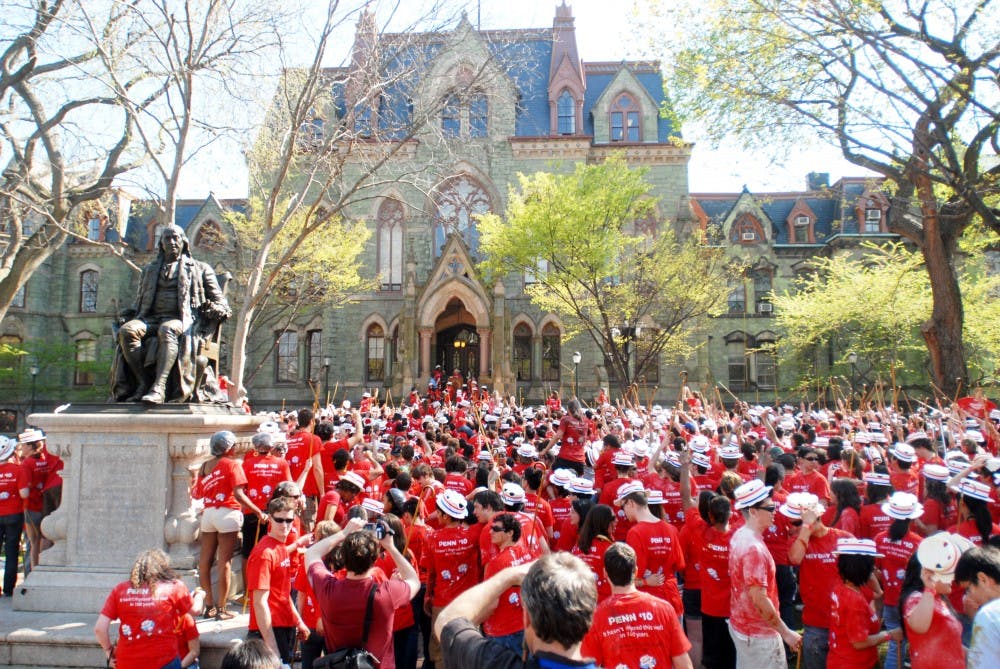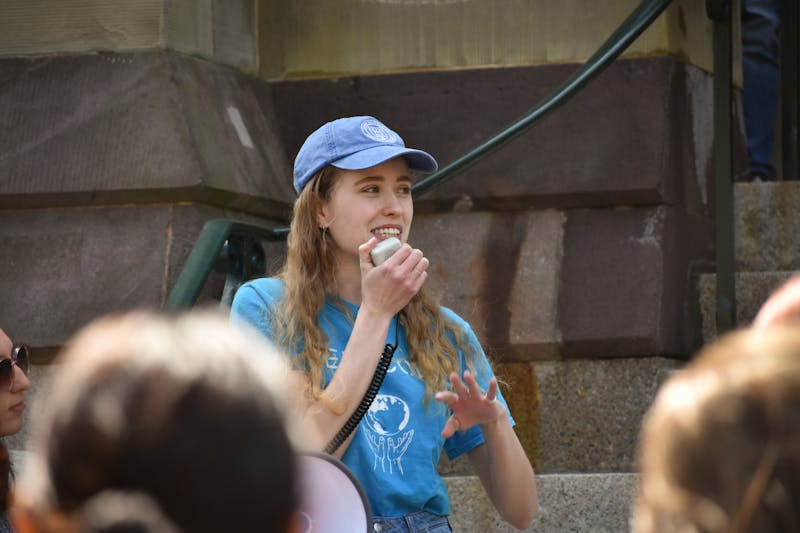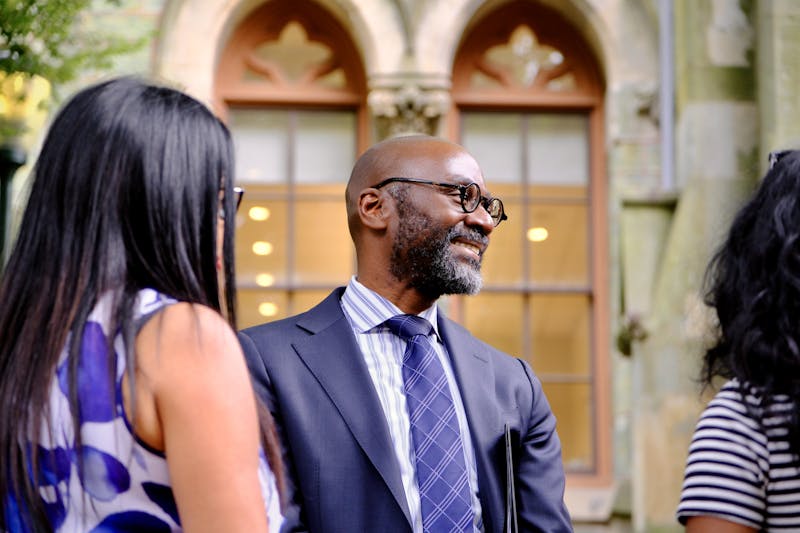
Every year, on the first day of reading days in April, the junior class celebrates their initial “moving up” as seniors in the annual Hey Day parade and celebration. Students march down Locust Walk dressed in red shirts, straw hats and canes, to President Amy Gutmann, who awaits the class on the steps of College Hall. Students roar and cheer, welcoming in their final year at Penn.
But before being officially crowned seniors, the junior class must answer three questions, part of an annual test. The University president, like presidents before, will ask:
“Who is the founder of the University of Pennsylvania?” “Who is your class president?” and “True or False: The Penn Class of [insert latest year here] will be the best senior class ever.”
But 2015 was not like the rest. “On our year, I don’t know if she did this by herself, but she changed the traditional questions,” said 2016 Class Board President Jesus Perez.
Instead of the traditional question, she asked, “How many Hey Days have there been?” and the class responded with an enthusiastic “One hundred.”
Gutmann then announced, “I hereby declare you century seniors,” acknowledging 2016 as the year of the 100th Hey Day. Tweets with the hashtags #CenturySenior and #HeyDay100 circulated online, and students caught up with Hey Day traditions from materials published by the University Archives and Records Center, Penn administration and The Daily Pennsylvanian.
“I was surprised,” Perez said. “‘I thought that was funny and a little special.”
But now, a year later, students from the Class of 2017 are also celebrating “100” in their Hey Day celebration, dubbed the “Centennial Hey Day” by the Class Board for the Class of 2017. But how can two classes celebrate the same anniversary?
In their freshman year, the 2016 Class Board, now seniors, realized that it would be a history-making class. Perez said the student government worked all three years, beginning “as soon as our year realized we’d be falling on the 100th [Hey Day].”
Yet from the beginning, they knew that the Class of 2017 would have a competing claim to history.
2017 Class Board Executive Vice President Max Levy said that the Class of 2017 began planning their Hey Day two summers ago. Conversations took place between the Undergraduate Assembly and the two class boards. “The good news was that Penn was really excited to help with both our classes,” he said.
The 2016 Class Board met with Penn Archives, where historians confirmed that, counting from the first celebration, 2015 would mark the 100th Hey Day. But, with the first Hey Day occurring in 1916, the Hey Day celebration for the Class of 2017 would fall on the 100th anniversary of the first Hey Day.
“They also said that [2016] would be the 100th anniversary,” Perez said. “But we used the same formula that the Super Bowl uses. So that’s how we did it. Hey Day 100.”
During the summer, Perez met with 2017 Class Board President Darren Tomasso to discuss developing plans for the Class of 2017 to celebrate as the 100th anniversary of Hey Day. “I had a very long conversation with Darren Tomasso. We agreed to disagree,” Perez said.
As of a few weeks ago, Levy said that the Class Board was still working on developing its activities and event marketing. It’s a process he describes as “centennialization,” a way to personalize the almost $50,000-event for this year’s juniors.
In some ways, the Hey Day of 2016 reflects a century of change.
Hey Day’s history stretches back to 1865, when an event then-titled “Class Day” is first documented. At the time, Penn was housed on 9th Street, across the city from its present-day campus in West Philadelphia.
Among other traditions, freshmen and sophomores participated in the Bowl Fight. The rules of the game were simple: Freshmen chose a classmate, designated the “bowlman,” and sophomores provided a bowl. The freshman class won if they managed to break the bowl before the sophomore class found the bowlman and placed him inside the bowl. If the sophomores accomplished their objective first, victory was theirs.
In 1919, the tradition was discontinued after freshman William Lifson died.
The more sentimental tradition of Ivy Day also grew out of Hey Day. Established in 1873, the day was set aside for the senior class. For the first Ivy Day, the class imported a twig of Ivy from Scotland and planted it along the side of College Hall. This tradition established ivy as “a lasting symbol for each year’s graduating class,” according to the University Archives’ website.
In later years, the day was used as an opportunity for antiwar protests, and in 1968, women were finally included in the celebration.
The now iconic tradition of cane-marching was only added in 1965. Even in 2015, the Class Board “fundamentally changed a lot of the events,” Perez said.
Last year, the Class of 2016 reduced the cost of the Hey Day package, after finding that one in five Penn students could not afford the $35 needed for a cane, hat and T-shirt. This year’s class has been awarded an increased budget for festivities.
“It’s an amazing tradition, either way. I think every class deserves to have an amazing Hey Day. And as seniors, we’re still participating.” Perez said. “Even though there’s this debate, it doesn’t take away from the magic of Hey Day.
“It’s a very fluid conversation. I don’t think there’s a right answer,” he added.
The Daily Pennsylvanian is an independent, student-run newspaper. Please consider making a donation to support the coverage that shapes the University. Your generosity ensures a future of strong journalism at Penn.
DonatePlease note All comments are eligible for publication in The Daily Pennsylvanian.







